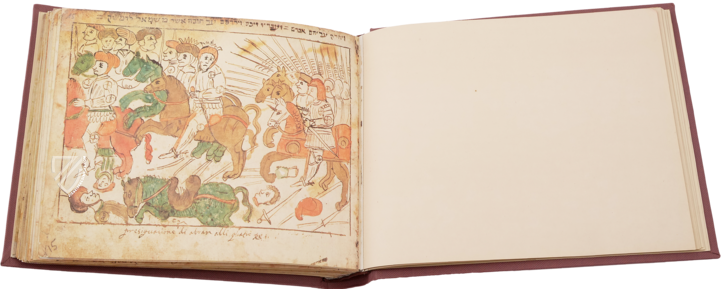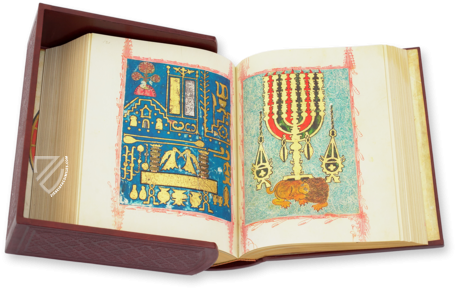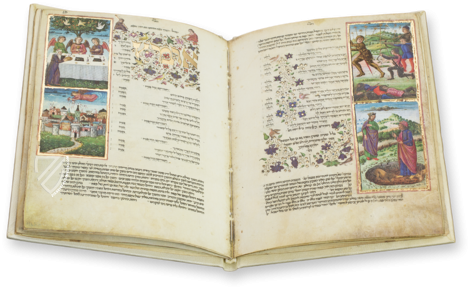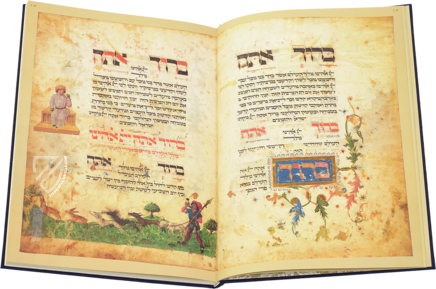Hebrew Bible
(3,000€ - 7,000€)
The famous Hebrew Bible from the collection of the El Escorial is a significant manuscript for the history of biblical editions. The precious bible contains the 24 books of the Jewish canon and is embellished with marvelous floral and geometric ornamentation. It served the Spanish Rabbi Alfonso de Zamora, inter alia, as a resources during his collaboration on the Compultensian Polyglot Bible, considered to be the first printed multilingual Bible. The manuscript was presumably used later by Benedictus Aria Montanus while he was directing the production of an edition of a polyglot bible in Antwerp at the behest Philip II. El Escorial’s Hebrew Bible is an extremely interesting object of historical study and a testimonial to the origins of 16th century Spanish polyglot bibles!
Hebrew Bible
The famous Hebrew Bible from the collection of the El Escorial is a significant manuscript for the history of biblical editions. The precious bible contains the 24 books of the Jewish canon and is embellished with marvelous floral and geometric ornamentation. It served the Spanish Rabbi Alfonso de Zamora, inter alia, as a resources during his collaboration on the Compultensian Polyglot Bible, considered to be the first printed multilingual Bible. The manuscript was presumably used later by Benedictus Aria Montanus while he was directing the production of an edition of a polyglot bible in Antwerp at the behest Philip II. El Escorial’s Hebrew Bible is an extremely interesting object of historical study and a testimonial to the origins of 16th century Spanish polyglot bibles!
The Great Hebraist
Afonso de Zamora (ca. 1477–1544) was a Spanish Rabbi who converted to Catholicism in 1506. He is considered to be the most important Hebraist of his time. As such, he participated in the creation of the Compultensian Polyglot Bible. This was the first printed polyglot bible in the world and was made at the behest of Cardinal Francisco Jiménez de Cisneros, Archbishop of Toledo, Queen Isabella of Castile’s confessor, and founder of the famous Universidad de Alcalá de Henares in the year 1500. The Polyglot appeared in six volumes from 1514 to 1517. Alfonso de Zamora devised the sixth volume, a dictionary for Hebrew, Chaldean, and Latin, which was essential for biblical study.
The Hebrew Bible of El Escorial
While working on this edition, Alfonso de Zamora depended upon one manuscript above all else: the famous Hebrew Bible, shelf mark G-II–8 from the El Escorial library. This 15th century bible encompasses 772 pages measuring 28.8 x 22.3 cm. It contains, as already betrayed by the title, the text of the Hebrew Bible. In accordance with the Talmud, this text is written on calfskin vellum in two columns in marvelous Spanish square script. Rich embellishments with ornaments in red, blue, and gold in the form of geometric and floral motives are found both in the biblical text as well as in the Masora magna. The manuscript contains the 24 books of the Jewish canon as well as the Masora parva and magna (“small and large Masora”) of the Pentateuch. A noble brown leather binding with bronze fittings and gorgeous embossing in the Mudéjar style rounds out the work of art.
Cornerstone of the Polyglot Bible
Seven specimens of the Bible were consulted for the formulation of the Polyglot Bible. The Hebrew Bible from the El Escorial is one of the most important among them. The manuscript was probably used once again for preparation of an edition of the Bible. The Spanish theologian Benedictus Arias Montanus took the Hebrew Bible with him to Flanders as he worked on the commission of King Philip II for the publication of a multi-lingual bible in Antwerp. Shelf mark G-II–8 is the only complete Jewish Bible at El Escorial. With the interesting irregularities in the text, which deviates from the norm, and the comments and marginal notations by Alfonso de Zamora, the manuscript is a very interesting object of study and a significant testimonial to the origins of the greatest biblical editions of the 16th century!
Codicology
- Alternative Titles
- Biblia Hebrea
Hebrew Bible - Size / Format
- 772 pages / 27.5 × 20.0 cm
- Origin
- Spain
- Date
- 16th century
- Epochs
- Style
- Illustrations
- Numerous gold decorated and headpieces, various ornaments in elaborate frames, one ornamental decorative page and some artful glosses
- Previous Owners
- Alfonso de Zamora (1474–1544)
Hebrew Bible
Incipit: Book of Genesis
Written in thick, shimmering gold, the word בְּרֵאשִׁית for “In the beginning” introduces the text of the Book of Genesis, which is written in two neatly ordered columns and surrounded by the same continuous gold and red frame that surrounds the incipit. The space around the golden letters is filled by a swirling tendril pattern executed in red and green ink. Fine examples of micrography, Jewish calligrams consisting of Hebrew texts arranged to create an image, can be seen in the upper margin in the form of various star shapes with golden dots outlined in red.

Hebrew Bible
Carpet Page
This magnificent carpet page is evidence of the way various cultures influenced one another’s art during the Middle Ages. Western carpet pages have their origins in Islamic art, which prohibited the depiction of human figures. As a result, Muslim artists focused on creating elaborate geometric and floral patterns, the kind that were often found on elaborate prayer rugs and which fill the borders of this carpet page.
The fleur-de-lys also features prominently on the page and although it is not an expressly Christian symbol, it is certainly not Jewish and has political, dynastic, and religious symbolism strongly associated with France and the ancient Frankish Kingdom from which it evolved. While some of the fleurs-de-lys are either solid silver or gold, most are a mix of the two and are presented in a field of interlocking gold and silver rings with a red and green background.

#1 Biblia Hebrea
Language: Spanish
(3,000€ - 7,000€)
- Treatises / Secular Books
- Apocalypses / Beatus
- Astronomy / Astrology
- Bestiaries
- Bibles / Gospels
- Chronicles / History / Law
- Geography / Maps
- Saints' Lives
- Islam / Oriental
- Judaism / Hebrew
- Single Leaf Collections
- Leonardo da Vinci
- Literature / Poetry
- Liturgical Manuscripts
- Medicine / Botany / Alchemy
- Music
- Mythology / Prophecies
- Psalters
- Other Religious Books
- Games / Hunting
- Private Devotion Books
- Other Genres
- Afghanistan
- Armenia
- Austria
- Belgium
- Colombia
- Croatia
- Cyprus
- Czech Republic
- Denmark
- Egypt
- Ethiopia
- France
- Germany
- Greece
- Hungary
- India
- Iran
- Iraq
- Israel
- Italy
- Japan
- Lebanon
- Luxembourg
- Mexico
- Morocco
- Netherlands
- Palestine
- Peru
- Poland
- Portugal
- Russia
- Serbia
- Spain
- Sri Lanka
- Sweden
- Switzerland
- Syria
- Turkey
- Ukraine
- United Kingdom
- United States
- Uzbekistan
- Aboca Museum
- Ajuntament de Valencia
- Akademie Verlag
- Akademische Druck- u. Verlagsanstalt (ADEVA)
- Aldo Ausilio Editore - Bottega d’Erasmo
- Alecto Historical Editions
- Alkuin Verlag
- Almqvist & Wiksell
- Amilcare Pizzi
- Andreas & Andreas Verlagsbuchhandlung
- Archa 90
- Archiv Verlag
- Archivi Edizioni
- Arnold Verlag
- ARS
- Ars Magna
- ArtCodex
- AyN Ediciones
- Azimuth Editions
- Badenia Verlag
- Bärenreiter-Verlag
- Belser Verlag
- Belser Verlag / WK Wertkontor
- Benziger Verlag
- Bernardinum Wydawnictwo
- BiblioGemma
- Biblioteca Apostolica Vaticana (Vaticanstadt, Vaticanstadt)
- Bibliotheca Palatina Faksimile Verlag
- Bibliotheca Rara
- Boydell & Brewer
- Bramante Edizioni
- Bredius Genootschap
- Brepols Publishers
- British Library
- C. Weckesser
- Caixa Catalunya
- Canesi
- CAPSA, Ars Scriptoria
- Caratzas Brothers, Publishers
- Carus Verlag
- Casamassima Libri
- Chavane Verlag
- Christian Brandstätter Verlag
- Circulo Cientifico
- Club Bibliófilo Versol
- Club du Livre
- CM Editores
- Collegium Graphicum
- Collezione Apocrifa Da Vinci
- Comissão Nacional para as Comemorações dos Descobrimentos Portugueses
- Coron Verlag
- Corvina
- CTHS
- D. S. Brewer
- Damon
- De Agostini/UTET
- De Nederlandsche Boekhandel
- De Schutter
- Deuschle & Stemmle
- Deutscher Verlag für Kunstwissenschaft
- DIAMM
- Droz
- E. Schreiber Graphische Kunstanstalten
- Ediciones Boreal
- Ediciones Grial
- Ediclube
- Edições Inapa
- Edilan
- Editalia
- Edition Deuschle
- Edition Georg Popp
- Edition Leipzig
- Edition Libri Illustri
- Editiones Reales Sitios S. L.
- Éditions de l'Oiseau Lyre
- Editions Medicina Rara
- Editorial Casariego
- Editorial Mintzoa
- Editrice Antenore
- Editrice Velar
- Edizioni Edison
- Egeria, S.L.
- Eikon Editores
- Electa
- Emery Walker Limited
- Enciclopèdia Catalana
- Eos-Verlag
- Ephesus Publishing
- Ernst Battenberg
- Eugrammia Press
- Extraordinary Editions
- Fackelverlag
- Facsimila Art & Edition
- Facsimile Editions Ltd.
- Facsimilia Art & Edition Ebert KG
- Faksimile Verlag
- Feuermann Verlag
- Folger Shakespeare Library
- Franco Cosimo Panini Editore
- Friedrich Wittig Verlag
- Fundación Hullera Vasco-Leonesa
- G. Braziller
- Gabriele Mazzotta Editore
- Gebr. Mann Verlag
- Gesellschaft für graphische Industrie
- Getty Research Institute
- Giovanni Domenico de Rossi
- Giunti Editore
- Graffiti
- Grafica European Center of Fine Arts
- Guido Pressler
- Guillermo Blazquez
- Gustav Kiepenheuer
- H. N. Abrams
- Harrassowitz
- Helikon
- Hendrickson Publishers
- Henning Oppermann
- Herder Verlag
- Hes & De Graaf Publishers
- Hoepli
- Holbein-Verlag
- Hortus Deliciarum
- Houghton Library
- Hugo Schmidt Verlag
- Idion Verlag
- Il Bulino, edizioni d'arte
- ILte
- Imago
- Insel Verlag
- Instituto Nacional de Antropología e Historia
- Istituto dell'Enciclopedia Italiana - Treccani
- Istituto Ellenico di Studi Bizantini e Postbizantini
- Istituto Geografico De Agostini
- Istituto Poligrafico e Zecca dello Stato
- Italarte Art Establishments
- J. Thorbecke
- Jan Thorbecke Verlag
- Johnson Reprint Corporation
- Josef Stocker
- Josef Stocker-Schmid
- Jugoslavija
- Karl W. Hiersemann
- Kasper Straube
- Kaydeda Ediciones
- Kindler Verlag / Coron Verlag
- Kodansha International Ltd.
- Konrad Kölbl Verlag
- Kurt Wolff Verlag
- La Liberia dello Stato
- La Linea Editrice
- La Meta Editore
- Lambert Schneider
- Landeskreditbank Baden-Württemberg
- Leo S. Olschki
- Les Incunables
- Library of Congress
- Libreria Musicale Italiana
- Lichtdruck
- Lito Immagine Editore
- Lumen Artis
- Lund Humphries
- M. Moleiro Editor
- Maison des Sciences de l'homme et de la société de Poitiers
- Manuscriptum
- Martinus Nijhoff
- Maruzen-Yushodo Co. Ltd.
- MASA
- McGraw-Hill
- Militos
- Millennium Liber
- Müller & Schindler
- Nahar and Steimatzky
- National Library of Wales
- Neri Pozza
- Nova Charta
- Oceanum Verlag
- Odeon
- Orbis Mediaevalis
- Orbis Pictus
- Österreichische Staatsdruckerei
- Oxford University Press
- Pageant Books
- Parzellers Buchverlag
- Patrimonio Ediciones
- Pattloch Verlag
- PIAF
- Pieper Verlag
- Plon-Nourrit et cie
- Prestel Verlag
- Princeton University Press
- Prisma Verlag
- Priuli & Verlucca, editori
- Pro Sport Verlag
- Propyläen Verlag
- Pytheas Books
- Quaternio Verlag Luzern
- Reales Sitios
- Recht-Verlag
- Reichert Verlag
- Reichsdruckerei
- Riehn & Reusch
- Roberto Vattori Editore
- Rosenkilde and Bagger
- Roxburghe Club
- Salerno Editrice
- Sarajevo Svjetlost
- Schöck ArtPrint Kft.
- Scolar Press
- Scrinium
- Scripta Maneant
- Scriptorium
- Siloé, arte y bibliofilia
- SISMEL - Edizioni del Galluzzo
- Sociedad Mexicana de Antropología
- Société des Bibliophiles & Iconophiles de Belgique
- Soncin Publishing
- Sorli Ediciones
- Stainer and Bell
- Studer
- Styria Verlag
- Sumptibus Pragopress
- Szegedi Tudomànyegyetem
- Taberna Libraria
- Tarshish Books
- Taschen
- Tempus Libri
- Testimonio Compañía Editorial
- Thames and Hudson
- The Clear Vue Publishing Partnership Limited
- The Facsimile Codex
- The Folio Society
- The Marquess of Normanby
- The Richard III and Yorkist History Trust
- Tip.Le.Co
- TouchArt
- TREC Publishing House
- TRI Publishing Co.
- Trident Editore
- Typis Regiae Officinae Polygraphicae
- Union Verlag Berlin
- Universidad de Granada
- University of California Press
- University of Chicago Press
- Urs Graf
- Vallecchi
- Van Wijnen
- VCH, Acta Humaniora
- VDI Verlag
- VEB Deutscher Verlag für Musik
- Verlag Anton Pustet / Andreas Verlag
- Verlag Bibliophile Drucke Josef Stocker
- Verlag der Münchner Drucke
- Verlag für Regionalgeschichte
- Verlag Styria
- Vicent Garcia Editores
- W. Turnowsky
- Waanders Printers
- Wiener Mechitharisten-Congregation (Wien, Österreich)
- Wissenschaftliche Buchgesellschaft
- Wydawnictwo Dolnoslaskie
- Xuntanza Editorial
- Zakład Narodowy
- Zollikofer AG































































